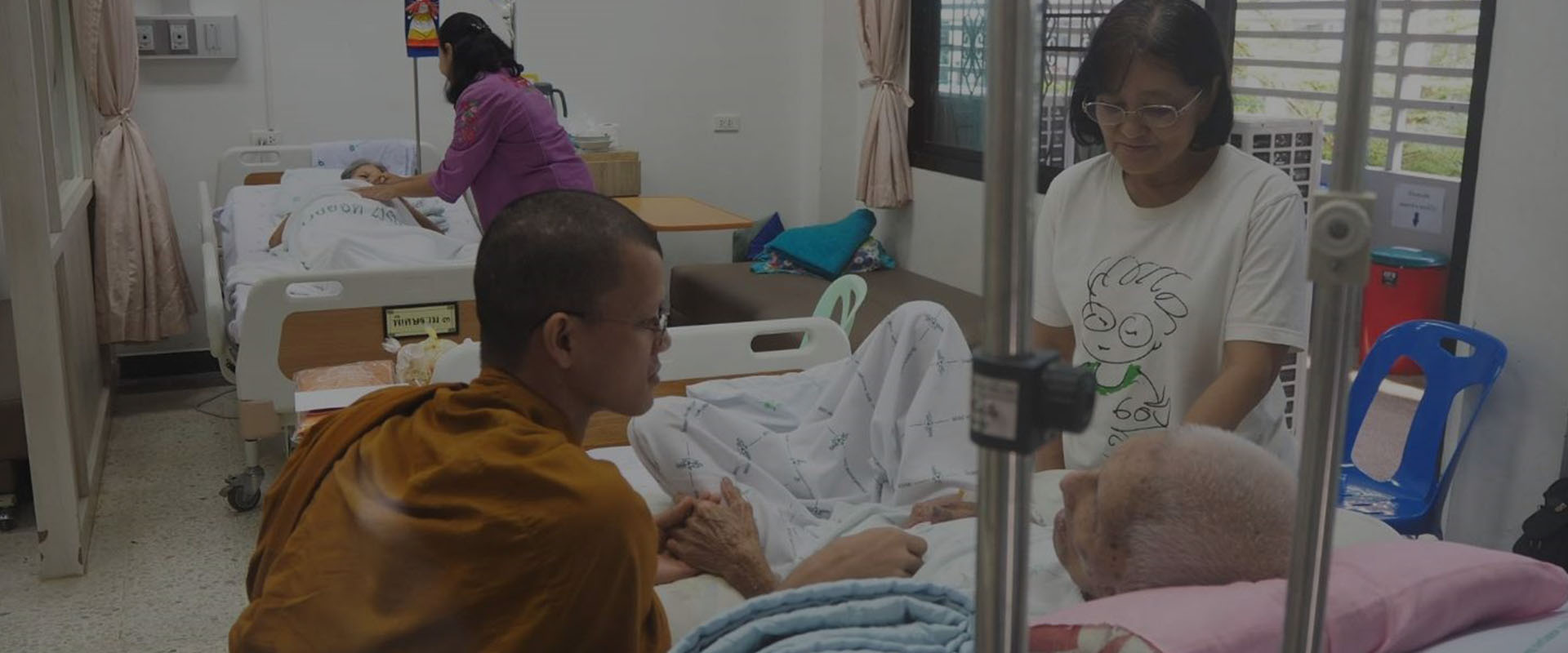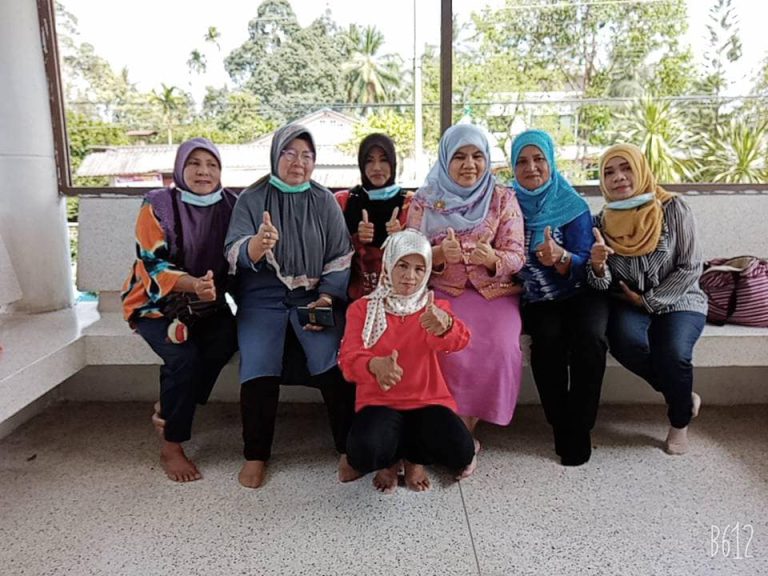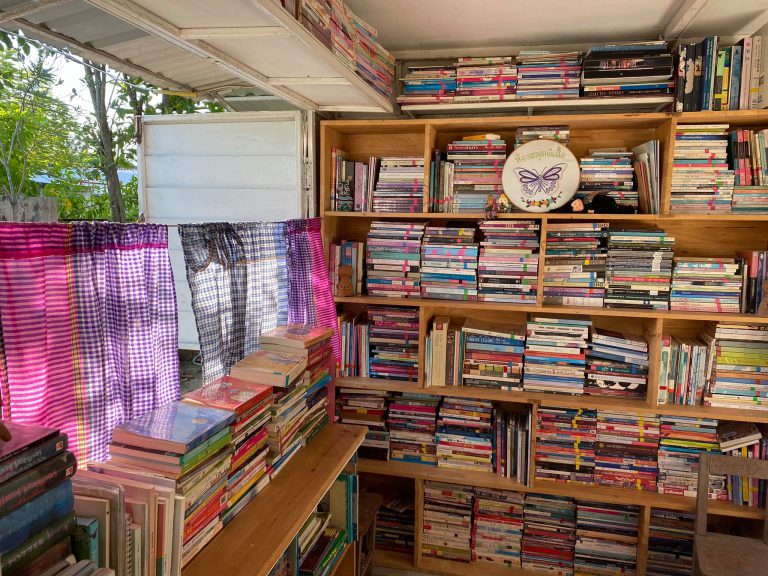Story: Woraphong Wechamaleenonda
The collective’s various activities — visiting patients in the hospital and the community, and distributing food and equipment — might seem like they are simply delivering supplies to patients and their families: run-of-the-mill social welfare. However, Phra Krodsada insists that “the collective isn’t merely engaged in social welfare work as everyone assumes, but is disseminating buddhist practice through the framework of community support and care. It embodies another form of dharmic practice that isn’t sitting and meditating, but is involved in bringing relief to others. The patients are like the dharma, and visiting them is a form of practice that is profoundly spiritual. We aren’t simply bringing them things”.
In addition to giving him the opportunity to get to know the people in the community and their ways of life, Phra Krodsada’s time with the Yellow Robe Collective has also enriched his understanding of the dharma. His encounters with sickness and death have given him more clarity on the nature and truth of life, which has helped him live his own life with greater ease. He doesn’t overthink things as he used to, and lets go of various anxieties and feelings more easily.
Upon reflecting on Phra Krodsada’s learning experiences, the collective decided to begin visiting members of the community outside of their circle of patients on every last Sunday of the month. They bring people who have donated to the collective’s cause to meet with patients, which gives them a level of spiritual consciousness. They are encouraged to see dharma as something that is manifest all around us. It is a way of teaching dharma as daily practice: though many of them may not go to the temple to pray, they are still able to practice dharma by helping others. If they develop an interest in pursuing buddhist practice further, they are invited to join meditation sessions, and listen to recitations of buddhist scriptures at Wat Huai Yod on buddhist holy days. The visits become an avenue for bringing community members closer to the temple.

The Healing Centre for Sick Monks
Over many years, the Yellow Robe Collective has taken care of end-stage patients, as well as housebound and bedridden individuals, who are all, for the most part, laypeople. Then one day, a monk raised the following question in one of their meetings: while monks take care of the sick in their communities, who will care for them when they fall ill? The question inspired Phra Krodsada to expand the scope of the collective’s work to sick monks. The collective is in the process of building a healing centre for monks at Huai Yod hospital, where they can have a place to stay and recover for about a month or less before their next doctor’s appointment, instead of having to travel back to their temples, which may be far away. Patients are also looked after by medical staff, who volunteer at the centre when they are not at work.
The collective hopes that the healing centre, in addition to providing for sick monks, will become a space that fosters awareness and learning opportunities for the youth and volunteer caregivers who help to bathe the patients and wash their robes. They also hope that it will raise awareness among monks back at the temple on the importance of taking care of each other when they fall sick.
The healing centre is currently under construction next to Wat Huai Yod’s “Centre for Learning and Healing”, and the collective are in the process of collecting funds and designing the building. The single-storey glass building will have a 5-6 bed capacity, with windows that open up to a view of the surroundings. The centre will only have shared rooms, with each patient given a bed and cupboard for their robes, in keeping with the buddhist renunciation of ownership, and to create a communal atmosphere based on understanding, respect and support for one another.
Cultivating a Culture of Healing
In addition to introducing an alternative form of dharmic practice by inviting community members on bedside visits, the Yellow Robe Collective is also experimenting with new activities that will challenge certain cultural attitudes and beliefs held by the people of Huai Yod. As part of the process of educating the community, they organised an event titled “Bringing Mindfulness into the New Year”, which held public discussions of death over new year’s. Though they received pushback from the abbot and some community members, who said that 60% of the Huai Yod population were chinese and would therefore consider talk of death over new year’s particularly sacrilegious, the collective were committed to organising the event. Beginning with a seminar on life, death and end-of-life care, the event moved on to a recitation of the maranasati (the sutra the Buddha gave to his disciples to practice constant mindfulness of death), and maranasati meditation. Participants listened to the verses on contemplation of death used in the Phutthika Buddhist Network’s peaceful death training. Then, to synthesize the key concepts of the event, participants were asked to exchange their own perspectives on dying with each other, which to a certain extent, was much more fruitful than expected.

“When we were organising “Bring Mindfulness to the New Year” and the maranasati session at the Wat Huai Yod, many of the chinese people at the market asked us how we could possibly talk about death during the auspicious period of New Year,” says Ms. Baramida, a volunteer with the collective who participated in the event. “Save it for the funeral, they said. But then on the day of the event, almost a hundred people came. At one point, the participants were asked whether or not they were prepared for death, and were divided into groups to discuss their reasons with one another. Then Phra Ajarn addressed everyone and talked about why we should be ready to die at any time. The event gave us new perspectives on death to talk about in an open and casual way.”
The collective has also successfully created another cultural shift towards health awareness by phasing out the practice of lighting incense in sermon halls. Traditionally, sermon halls contain numerous buddha images and incense burners. On holy days, the temple is visited by up to 600-700 people, and the burning of incense fills the hall with clouds of smoke as according to buddhist belief, prayers will not reach the buddha without the burning of incense. Novice monks are tasked with collecting the incense sticks in buckets of water to prevent fires. The collective’s first step in their process of changing this convention was to discuss the issue with the abbot and sangha. Once they were all in agreement, the collective began reducing the number of incense holders in front of the small buddha images, before announcing that incense burning would no longer be allowed at the temple. At first, disgruntled community members remarked that if the temple prohibited people from burning incense, then they would barely have any visitors, if any. However, the collective’s healing and caregiving activities had become well-known throughout the community, and they were able to explain that they were annulling incense burning out of concern for everyone’s health. Once community members saw that the collective was well-intentioned, they became more open to the change, and adjusted their practice accordingly. Within less than half a year, Wat Huai Yod stopped burning incense for good.

Beginning with visits to end-stage patients in hospitals, the collective slowly expanded their activities to include visits to sick individuals in the community, and began working towards building an environment of healing and caregiving in the community. “All of the collective’s activities are connected by our main goal, which is to educate and involve communities in patient care,” emphasizes Phra Krodsada. “We want to build communities of healing and compassion where people care for each other and can rely on one another for support.”
Interviews conducted:
- Phra Krodsada Khantigaro, president of the Huai Yod Yellow Robe Collective in Service of End-stage Patients
- Darunee Chanachai, a professionally-trained palliative care nurse at the Arokayasala centre, Huai Yod hospital
- Barmita Liao Phatthanaphong, a village health volunteer, caregiver and assistant of the Yellow Robe Collective
Photographs:
- FB: Phra Krodsada Khantigaro, the sangha of spiritual healing
- The Yellow Robe Collective in Service of End-stage Patients
- Arokayasala centre, Huai Yod hospital
He decided to begin caring for other sick people in the community as well.



